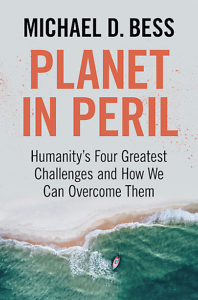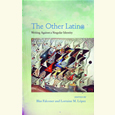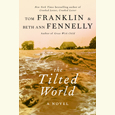Scared Yet?
Vanderbilt historian Michael Bess explores four ways humanity might destroy itself
Never mind Hollywood reboots of Halloween, Scream, and The Texas Chainsaw Massacre: If you want true classic terror, read Michael Bess’ Planet in Peril: Humanity’s Four Greatest Challenges and How We Can Overcome Them.
 The Vanderbilt historian and professor in communication of science and technology dives deeply into four familiar forms of global mayhem, providing all the frightening details of a good dystopian novel. Specifically, Bess considers the threats of global warming (and its attendant problem of fossil fuels), nuclear weapons (and energy), pandemics (both natural and engineered), and runaway artificial intelligence. “The four technologies create planet-level dangers that can only be effectively addressed with planet-level solutions,” Bess writes in his introduction. He argues that any of the four could lead to mass human extinction, bolstering his predictions not only with research into worst-case scenarios, but through 11 science fiction vignettes, both scary and reassuring.
The Vanderbilt historian and professor in communication of science and technology dives deeply into four familiar forms of global mayhem, providing all the frightening details of a good dystopian novel. Specifically, Bess considers the threats of global warming (and its attendant problem of fossil fuels), nuclear weapons (and energy), pandemics (both natural and engineered), and runaway artificial intelligence. “The four technologies create planet-level dangers that can only be effectively addressed with planet-level solutions,” Bess writes in his introduction. He argues that any of the four could lead to mass human extinction, bolstering his predictions not only with research into worst-case scenarios, but through 11 science fiction vignettes, both scary and reassuring.
The first vignette, for example, is set in 2029. Bess relates “How Jim and Evelyn’s Virus Accidentally Killed Half the World.” Using off-the-shelf hardware and commercially available bits of DNA from the 1918 Spanish flu, two high school friends hoping to get into Stanford create a deadly virus in Evelyn’s parents’ garage. An earthquake knocks a machine off the table, releasing their experiment. The fresh plague infects billions before the first symptoms appear, killing most victims in five days. Wildlife reclaims large swaths of the planet while surviving humanity degenerates into roving bands of marauders.
 More than 100 pages later, Bess revisits the scenario, this time setting it in 2054, with “How Jim and Evelyn Were Prevented from Killing Half the World,” showing how three decades of development of internationally enforced protocols for cellular engineering make all the difference. Eight bulleted paragraphs list separate safeguards that keep any desktop plague from wreaking havoc. This stick-and-carrot approach, presenting doomsday facts and speculations followed by the author’s ideas on how to avoid them, helps pages of carefully footnoted reporting become an engrossing — if often horrifying — read.
More than 100 pages later, Bess revisits the scenario, this time setting it in 2054, with “How Jim and Evelyn Were Prevented from Killing Half the World,” showing how three decades of development of internationally enforced protocols for cellular engineering make all the difference. Eight bulleted paragraphs list separate safeguards that keep any desktop plague from wreaking havoc. This stick-and-carrot approach, presenting doomsday facts and speculations followed by the author’s ideas on how to avoid them, helps pages of carefully footnoted reporting become an engrossing — if often horrifying — read.
Bess used similar fictional scenes to explain complex ideas in Our Grandchildren Redesigned, his 2015 book on human bioengineering. “I think it’s important, in talking about the future, to stay true to the very real space that exists for human choice and effective action,” he explained then in a Chapter 16 interview. “One of the advantages of being a historian is that I have a clear sense of the ways in which past individuals and past societies have been able to have a say in shaping their world.” Other vignettes in Planet in Peril include “The Eleven-Minute Cyberwar,” “Going to War over Sunlight?” and “The UN Army Neutralizes a Genocide.” Professor Bess serves each up as the sort of reward he might deliver to a class for paying attention to a lecture filled with theories and PowerPoint equations.
While the first half of Planet in Peril focuses mostly on ways his particular four horsemen might be loosed to ravage the world, the second half offers possible solutions — all of which would require decades of global effort. Acknowledging that worldwide cooperation seems unlikely in the face of authoritarian strongmen like Vladimir Putin and Kim Jong-un, at a time when even the most democratic nations seldom agree internally on environmental legislation, Bess takes a historian’s view of how the world has escaped the “sovereignty trap” in the past, starting with the Peace of Westphalia in 1648 and the rise of nations. “As the modern state-system emerged, it stabilized the territorial spaces of the world,” he writes, “and outbursts of violence among local groups and factions dramatically declined.”
Bess looks at moments when multiple sovereign states banded together for mutual aid, via organizations like NATO, the EU, and the Organization of Economic Co-operation and Development. “Cooperating with other people is relatively easy when the benefits are clear and the ground rules already agreed upon,” he concludes, after detailing how a United Nations with true regulatory power could emerge over time. Lest readers begin to feel too hopeful, Bess offers a penultimate chapter entitled, “What Could Go Wrong?” He lists plenty, from a tipping point of runaway global heating to a single power-hungry tyrant destabilizing global accords. Although Bess believes that his proposed solutions offer mutual benefit to participating nations, he admits, “This by no means implies that the functioning of such a world government would be peaches and cream.”
And yet in his conclusion, the historian claims that he began the book because things looked “really bad,” but actually researching and writing it changed his perspective: “Strange as it seems, I am more optimistic now than when I started this project.” In the end, Planet in Peril illuminates paths that may allow humanity to escape destruction — but this doesn’t mean readers will sleep any better after setting it down.

Michael Ray Taylor is the author of Hidden Nature and other books. He lives in Arkansas.


